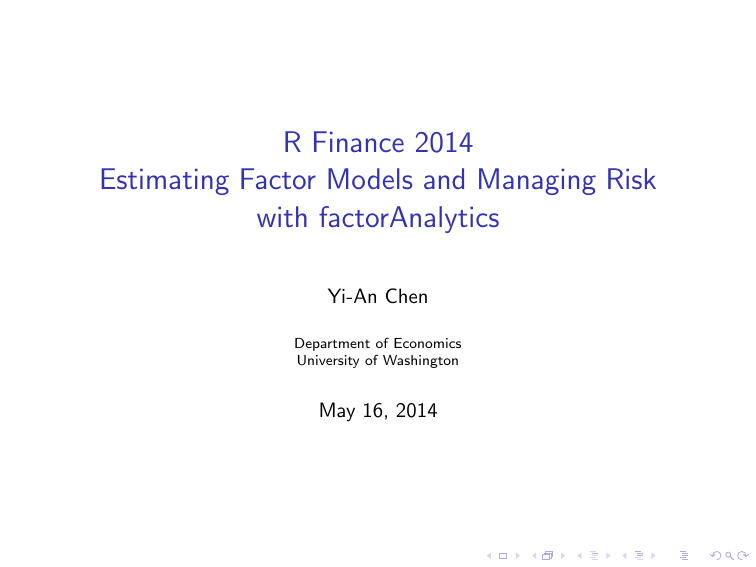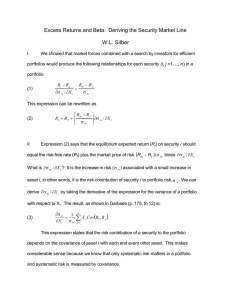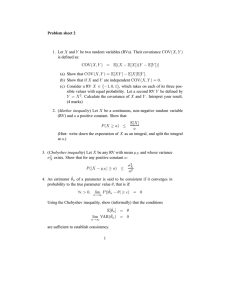R Finance 2014 Estimating Factor Models and Managing Risk with
advertisement

R Finance 2014
Estimating Factor Models and Managing Risk
with factorAnalytics
Yi-An Chen
Department of Economics
University of Washington
May 16, 2014
Road map
Overview of factorAnalytics
Estimating Factor Model
Risk Management
Background of factorAnaltyics
◮
◮
◮
◮
◮
◮
R package “factorAnalytics” is designed for factor models estimation
and risk management.
It has 21 functions and 3 demo data so far, as well as an user
friendly vignette.
It talks to “PerformanceAnalytics” with portfolio risk analytics.
It was one of the many projects of R, Statistical computing
participating in Google Summer of Codes 2013.
It is now a branch project of “ReturnAnalytics” and currently lives
under it on the R-forge.
Developers include Brian Peterson, Doug Martin, Eric Zivot, Guy
Yollin, Peter Carl and Yi-An Chen.
Main Functions
◮
Estimating: fitTimeSeriesFactorModel.r,
fitFundamentalFactorModel.r, fitStatisticalFactorModel.r
◮
Risk managing : factorModelSdDecomposition.r,
factorModelVaRDecomposition.r, factorModelEsDecomposition.r
◮
Other misc. functions : factorModelCovariance.r,
factorModelMonteCarlo.r
◮
Generic functions for fitting: plot(), predict(), summary(), print()
Introduction
Factor models for asset returns are used to
◮
Decompose risk and return into explainable and unexplainable
components
◮
Generate estimates of abnormal return
Describe the covariance structure of returns
◮
◮
◮
Predict returns in specified stress scenarios
Provide a framework for portfolio risk analysis
Factor Model in General Form
A factor model is defined as
Rit = αi + β1i f1t + β2i f2t + · · · + βKi fKt + ǫit
= αi + βi′ ft + ǫit
Where
◮
◮
◮
◮
Rt is simple returns or excess returns on asset i (i = 1 · · · N) and in
time period t (t= 1 · · · T).
βki is factor exposures or factor loadings for asset i on kth factor.
fkt is common risk factor (k = 1 · · · K).
ǫit is asset specific returns or residual returns.
Assumption
1. The common risk factors, ft , are stationary with unconditional
moments
E[ft ] = µf
cov(ft ) = E[(ft − µf )(ft − µf )] = Ωf
2. Asset specific returns, ǫit , are uncorrelated to each common risk
factors fkt .
cov(fkt , ǫit ) = 0, ∀ k, i, t
3. Error terms, ǫit , are serially uncorrelated and contemporaneously
uncorrelated across assets
cov(ǫit , ǫjt ) = σi2 , ∀ i = j, t = s
= 0, otherwise
Three types of models
Factor Model:
Rit = αi + βi′ ft + ǫit
According to different model setup, 3 main different types of models:
◮ Common factor ft is known, it is called time series factor model.
◮
Factor loadings β are known, from firm characteristics. It is called
fundamental factor model.
◮
both β and ft are unknown and extracted from asset returns, it is
called statistical factor model.
Fitting Time Series Factor Model
Factor model can be written as time-series regression model for asset i:
Ri = 1T αi + F βi + ǫi , i = 1, · · · , N
where
◮
Ri is T × 1,
◮
αi is scalar,
F is T × K common risk factors,
◮
◮
◮
βi is K × 1 vector,
E[ǫ2i ] = σi2 , time-series homoskedasticity.
Estimation can be done by N times time-series regression. Function
“fitTimeSeriesFactorModel()” is design to do it.
fitTimeSeriesFactorModel()
> args(fitTimeSeriesFactorModel)
function (assets.names, factors.names, data = data, num.factor.s
fit.method = c("OLS", "DLS", "Robust"), variable.selection =
decay.factor = 0.95, nvmax = 8, force.in = NULL, subsets.met
"backward", "forward", "seqrep"), lars.criteria = "Cp",
add.up.market.returns = FALSE, add.quadratic.term = FALSE,
excess.market.returns.name)
◮
◮
3 different estimation methods: OLS(lm), DLS(wls), Robust(lmRob)
support different model selection methods :
1. “none” for no selection,
2. “stepwise” is forward/backward stepwise OLS regression (step() or
step.lmRob() ),
3. “all subsets” is all subsets regression (regsubsets()), subsets methods
are “exhaustive”, “backward”, “forward” and “seqrep”
4. “lar” , “lasso” is based on package ”lar”
(Go to R script.)
Market Timing Model
Henriksson-Merton Model (1981)
Rp,t − Rf = α + β(Rm,t − Rf ) + γD + ǫt
where
◮ Rt is asset returns, Rm is market returns, Rf is risk-free rate.
D = max(0,Rm,t − Rf ) mimicking payoff to an put option.
γ is market timing ability. Numbers of free puts generated by
manager’s strategy.
Treynor-Mazuy Model (1966)
◮
◮
Rp,t − Rf = α + β(Rm,t − Rf ) + γ(Rm,t − Rf )2 + ǫt
If γ is positive, it indicates the manager’s investment strategy having
market timing ability, making more when market is up and loss less when
it is down.
Fitting Statistical Factor Model
◮
◮
◮
In statistical factor models, the factor realizations ft are not directly
observable and must be extracted from the observable returns Rt
using statistical methods. The primary methods are factor analysis
and principal components analysis.
Traditional factor analysis and principal component analysis are
usually applied to extract the factor realizations if the number of
time series observations, T, is greater than the number of assets, N.
If N > T, then the sample covariance matrix of returns becomes
singular which complicates traditional factor and principal
components analysis. In this case, the method of “asymptotic
principal component analysis” is more appropriate.
Factor Analysis
Rt = µ + |{z}
B ft + ǫt , t = 1, · · · , T
|{z}
|{z} |{z}
|{z}
N×1
◮
◮
◮
◮
◮
N×K
N×K K ×1
N×1
cov(ft , ǫt )=0, for all t,s
E[ft ] = E[ǫt ] = 0
var(ft ) = 1K
var(ǫt ) = D, where D is diagonal matrix with σi2 along the diagonal.
Return covariance matrix Ω can be decomposed as
Ω = BB ′ + D
◮
If T > N, it is a traditional factor model. Error term ǫit is assumed
no serial and cross-sectional correlation for all i,t.
Traditional Factor Model Estimation
When T > N, Sample principal components are computed from the
spectral decomposition of the N × N sample covariance matrix Ω̂N :
Ω̂N = P̂ Λ̂P̂ ′
. . .
P̂ = [pˆ1 ..pˆ2 .. · · · ..pˆN ], P̂ ′ = P̂ −1
Λ̂ = diag(λ̂1 , · · · , λ̂N ), λ̂1 > λ̂2 > · · · > λ̂N
where P is matrix of orthonormal eigenvectors and Λ are corresponding
eigenvalues. The estimated factor realizations are simply the first K
sample principle components
fˆkt = p̂k′ Rt , k = 1, · · · , K ,
fˆt = (fˆ1t , · · · , fˆKt )
The factor loading for each assets, βi and the residual variance σi2 can be
estimated via OLS from the time series regression
Rit = αi + βi′ fˆt + ǫit , t = 1, · · · , T
Asymptotic Principle Components
◮
◮
When N >T, Asymptotic principal component analysis (APCA) by
Conner and Korajczyk (1986) will be used.
APCA is based on eigenvector analysis of the T × T matrix Ω̂T .
APCA estimates of factor fk are the first K eigenvectors of Ω̂T .
.
.
That is F̂ = [f .. · · · ..f ] is an orthonormal T × K matrix.
1
K
◮
It works easier with T × T matrix Ω̂T rather than N × N matrix Ω̂N
when N grows large.
◮
It allows approximate factor structure of returns. ǫit are allowed
weakly cross-sectional correlation which is more realistic assumption.
Conner and Korajczyk (1986) and Bai and Ng (2002) methods can
be used to determine numbers of factors when N > T.
◮
(Go to R script)
Fitting Fundamental Factor Model
Fundamental factor models use observable asset specific characteristics
(fundamentals) like industry classification, market capitalization, style
classification (value, growth) etc. to determine the common risk factors.
◮
◮
◮
◮
Factor loading β are from observable firm characteristics.
Common risk factor ft are estimated at each t give β
BARRA approach: Estimate ft at time t given firm characteristics β.
That is to say, running T cross-section regressions
“fitFundamentalFactorModel()” can estimate fundamental factor
model.
Example: BARRA type single factor model
A simple model in the form of a cross-sectional regression at time t :
Rt = β ft + ǫt , t = 1, · · · , T
|{z}
|{z} |{z} |{z}
N×1
N×1 1×1
N×1
◮
β is N × 1 observed firm characteristics.
◮
ft is unobserved factor realization.
cov(ft , ǫit ) = 0, var(ft ) = σf2 for all i, t
◮
◮
◮
Heteroskedasticity in error term : var(ǫit ) = σi2 for all i = 1,· · · ,N
Estimation fˆt can be done by Weighted Least Square (WLS)
cross-sectionally at each time t.
fitFundamentalFactorModel()
> args(fitFundamentalFactorModel)
function (data, exposure.names, datevar, returnsvar, assetvar,
wls = TRUE, regression = "classic", covariance = "classic",
full.resid.cov = FALSE, robust.scale = FALSE,
standardized.factor.exposure = FALSE, weight.var)
◮
data is panel like (T × N) × K data.frame. exposure.names is
colnames of factor loadings.
◮
datevar indicates date variables and should be xts identifiable
◮
returnsvar indicates returns variables. In order to talk to
PerformanceAnalytics. Do not use %.
◮
assetvar indicates assets variables.
(Go to R script)
Cont.
> args(fitFundamentalFactorModel)
function (data, exposure.names, datevar, returnsvar, assetvar,
wls = TRUE, regression = "classic", covariance = "classic",
full.resid.cov = FALSE, robust.scale = FALSE,
standardized.factor.exposure = FALSE, weight.var)
◮
wls can be chosen to be TRUE or FASLE
◮
regression method can be chosen as classic or robust (lmRob())
covariance method can be chosen as classic or robust (covRob())
◮
◮
If full.resid.cov controls is TRUE, residual covariance matrix is not
diagonal but full.
◮
If standardized.factor.exposure logical is TRUE. Factor exposure will
be standardized to regression weighted mean 0 and standardized
deviation to 1.
(Go to R script)
BARRA type Industry Model
The industry model with K industries is defined as :
Rit = β1i f1t + β2i f2t + · · · + βKi fKt + ǫit , i = 1, · · · , N, t = 1, · · · , T
var(ǫit ) = σi2 , i = 1, · · · , N
cov(ǫit , fjt ) = 0, j = 1, · · · K , i = 1, · · · , N
cov(fit , fjt ) = σij2 , i, j = 1, · · · K
where
βik = 1, if asset i is in industry k
= 0, otherwise
(Go to R script)
Factor Risk Budgeting
◮
Additively decompose (slice and dice) individual asset or portfolio
return risk measures into factor contributions
◮
Allow portfolio manager to know sources of factor risk for allocation
and hedging purposes
Allow risk manager to evaluate portfolio from factor risk perspective
◮
Factor Risk Decompositions Assume asset or portfolio return Rt can be
explained by a factor model
Rt = α + β ′ ft + ǫt
ft ∼ iid(µf , Ωf ), ǫt ∼ iid(0, σǫ2 ), cov(fk,t , ǫs ) = 0, ∀k, t, s
Rewrite the factor model as
Rt = α + β ′ ft + ǫt = α + β ′ ft + σǫ × zt
= α + β̄ ′ f¯t
ǫt
β̄ = (β ′ , σǫ )′ , f¯t = (ft , zt )′ , zt =
∼ iid(0, 1)
σ
ǫ
Ωf 0
2
σFM
= β̄ ′ Ω¯f β̄, Ω¯f =
0 1
Euler’s Theorem and Risk Decomposition
Let RM(β̄) denote the risk measure σFM , VaRαFM and ETLFM
α as function
of β. We have following risk decomposition:
RM(β̄) =
K
+1
X
j=1
β̄j
∂RM(β̄)
∂ β̄j
∂RM(β̄)
∂RM(β̄)
∂RM(β̄)
+ β̄2
+ · · · + β̄K +1
∂ β̄1
∂ β̄2
∂ β̄K +1
¯
∂RM(β̄)
∂RM(β)
∂RM(β̄)
+ · · · + βK
+ σǫ
= β1
∂β1
∂βK
∂σǫ
= β̄1
Terminology
Factor j marginal contribution to risk
∂RM(β̄)
∂ β̄j
Factor j contribution to risk
β̄j
∂RM(β̄)
∂ β̄j
Factor j percentage contribution to risk
β̄)
β̄1 ∂RM(
∂ β̄
1
RM(β̄)
It can be shown that:
∂VaRαFM (β̄)
= E[f¯t |Rt = VaRαFM (β̄)], j = 1, · · · , K + 1
∂ β̄j
∂ETLFM
α (β̄)
= E[f¯t |Rt ≤ VaRαFM (β̄)], j = 1, · · · , K + 1
∂ β̄j
Remarks:
◮
◮
Intuitive interpretation as stress loss scenario.
Analytic results are available under normality.
(Go to R script)
Factor Model Monte Carlo
Problem: Short history and incomplete data limits applicability of
historical simulation, and risk budgeting calculations are extremely
difficult for nonnormal distributions
◮
Use fitted factor model to simulate pseudo assets return data
preserving empirical characteristics
◮
Use full history for factors (t=1,· · · ,T) and observed history for asset
returns (t=ti , · · · , T ). Data structure is unequal.
Do not assume full parametric distributions for assets returns and
risk factor returns
Estimate tail risk and related measures non-parametrically from
simulated return data
◮
◮
Simulation Algorithm
Estimate factor models for each asset using partial history for assets and
risk factors.
Rit = α̂it + β̂i′ ft + ǫ̂it , t = ti , · · · , T
Simulate B values of risk factors by resampling with replacement from
full history of risk factor:
f1∗ , · · · , fB∗
Simulate B values of the factor model residuals from empirical
distribution or fitted non-normal distribution
ǫ̂∗1 , · · · , ǫ̂∗B
Create pseudo factor model returns from fitted factor model parameters,
simulated factor variables and simulated residuals:
Rit∗ = β̂i′ ft∗ + ǫ̂∗it , t = 1, · · · , B
Check out factorAnalytics
It is downloable on R-forge
https://r-forge.r-project.org/R/?group_id=579
Thanks You for Coming
Comments Welcome
Yi-An Chen
Email: chenyian@uw.edu


